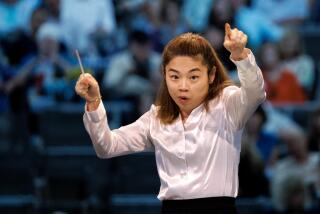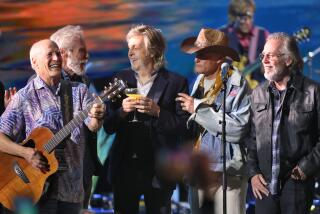An Explosive Brubeck Brings New Rhythms to the Bowl
Dave Brubeck promised to deliver some new material Wednesday night in his appearance at Lexus Jazz at the Bowl, and that’s exactly what he did. The veteran jazz pianist-composer may be celebrating his 80th birthday this year, but neither his compositions nor his playing revealed any signs of wear.
He actually kicked off his set with a whimsical story describing how he learned an unusual rhythm from some Native Americans at a concert in New Orleans.
“I decided that I was going to use it some time in a composition,” he said. “And now’s the time.”
The rhythm--not unlike the infectious beat popularized by Bo Diddley--became the foundation for a characteristically explosive Brubeck piece, with his big, two-handed chordal clusters providing incendiary support for soloing by alto saxophonist Bobby Militello.
Other new pieces followed: a lovely theme titled “All My Love,” the rhythmic “Why Not?”
Another number, opening with a rhapsodic piano solo filled with leaping intervals and piquant harmonies, one of his more unusual works, was unidentified. But there was no need to name the final work--Paul Desmond’s classic “Take Five”--which was offered with an added bit of nostalgia when 77-year-old Eugene Wright, who played on the original album, joined the quartet for the performance.
Despite Brubeck’s obvious crowd-pleasing appeal, he was very nearly upstaged by the remarkable appearance of Australian multi-instrumentalist James Morrison. Starting with “Don’t Get Around Much Anymore,” he whipped through the theme on trombone, switched to trumpet for a high-note version of “Struttin’ With Some Barbecue,” to fluegelhorn for a sweet ballad rendering of “I Thought About You” and back to trombone for “Things Ain’t What They Used to Be.”
He was superb throughout, playing with prime-time quality on each instrument, and the audience was appropriately responsive, giving him a standing ovation. What most were unaware of was the fact that Morrison elected (it’s not clear why) to not include either saxophone or piano in his battery of instruments, even though he plays both with similar expertise.
With this kind of visiting talent on hand, the Clayton-Hamilton Jazz Orchestra played a somewhat more modest role than usual. But the opening “Foot” included a memorable solo excursion from Ricky Woodard, “Little Old Lady” provided John Clayton with the opportunity to explain jazz orchestration, and trumpeter Clay Jenkins (who will be teaching at the Eastman School of Music in Rochester, N.Y. in the fall) offered a lyrical tribute to Louis Armstrong via a well-crafted arrangement by the band’s youngest member, trombonist Isaac Smith.
More to Read
The biggest entertainment stories
Get our big stories about Hollywood, film, television, music, arts, culture and more right in your inbox as soon as they publish.
You may occasionally receive promotional content from the Los Angeles Times.









